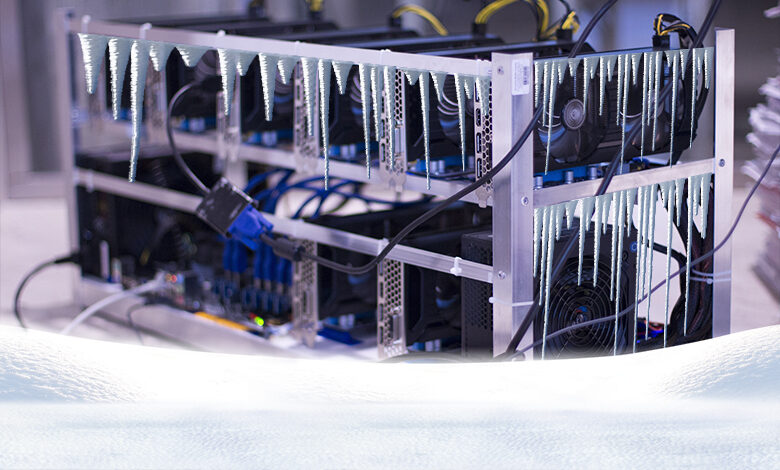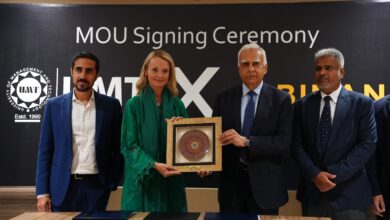Revolutionizing Bitcoin Mining: Cooling Methods for Enhanced Efficiency

Bitcoin mining has long been recognized as an energy-intensive and heat-generating process. As the Bitcoin mining industry continues to evolve and the 2024 Bitcoin Halving approaches, miners are increasingly seeking innovative ways to cool their equipment without compromising productivity and profit. Traditional air cooling methods, while common, are being scrutinized for their limitations, leading to the exploration of alternative cooling solutions, notably hydro cooling and immersion cooling.
The MENA region has emerged as a significant player in the cryptocurrency mining industry, with a focus on implementing innovative cooling solutions to enhance operational efficiency and sustainability. In this dynamic landscape, companies like Phoenix Group and Exahertz are pioneering the adoption of advanced cooling methods, shaping the direction of the industry in the region.
The Evolution of Bitcoin Mining Equipment
Bitcoin mining involves solving complex mathematical puzzles to create new bitcoins. Over time, mining equipment has evolved from a personal computer’s central processing unit (CPU) to more advanced hardware. While GPU mining marked a significant improvement over CPU mining, it wasn’t long before even more powerful hardware became available. In 2013, Field-Programmable Gate Arrays (FPGAs) and Application-Specific Integrated Circuits (ASICs) emerged as the next evolution in bitcoin mining technology. However, even with these advancements, the most efficient miners still face challenges related to overheating and efficient cooling methods.
The Significance of Avoiding Overheating
Effective cooling is vital in cryptocurrency mining, impacting miners’ success and profitability. High temperatures can significantly reduce a mining rig’s hashrate, which directly affects computational power and the ability to solve cryptographic puzzles. Overheating leads to reduced workloads, fewer mined blocks, and lower rewards. Furthermore, it escalates energy consumption, increasing electricity costs, a major expense in mining. Overheating also accelerates hardware wear and tear, raising maintenance expenses and shortening equipment lifespan. To maintain competitiveness and achieve a positive ROI, miners must prioritize efficient cooling to prevent overheating and ensure long-term operational sustainability.
Cooling Methods for Bitcoin Mining Equipment
Air Cooling
Air cooling relies on ventilation fans and atmospheric air to regulate equipment temperature. Mining rigs typically have built-in high-velocity fans which force airflow over their internal components, but additional air-cooling containers may be necessary. In cold weather, a combination of ambient and recirculated air can be used. The efficiency of air cooling can be improved with energy-intensive refrigeration components like chillers and air handlers.
Immersion Cooling
Immersion cooling stands out as a rapidly advancing cooling technique. It involves submerging the mining rig completely in a thermally conductive liquid with superior insulating properties compared to air. The liquid makes direct contact with the mining components, leading to highly efficient heat dissipation. Ideally, the cooling fluid possesses a high coefficient of heat rejection and low thermal resistance. These fluids must also be “dielectric,” meaning they do not conduct electricity. Immersion cooling can use synthetic, mineral, bio oils, or engineered fluids as coolants, all of which are environmentally friendly and reduce the ecological impact of cryptocurrency mining.
There are two primary approaches to immersion cooling: single-phase and double-phase. In single-phase immersion cooling, components are submerged in a dielectric fluid, which absorbs the heat generated by the components. The fluid is then pumped and circulated around a tank to remove the heat. In contrast, double-phase immersion cooling involves sealing servers within a bath of specially engineered fluorocarbon-based liquid. This liquid undergoes a phase change from liquid to gas due to the heat, and the vapor is condensed back into a liquid to be recycled through the system. Immersion cooling can recapture around 40% of the heat produced, which can be used to power the mining rig, making it highly efficient.
Hydro Cooling
Hydro cooling, also known as liquid cooling, employs deionized water as the heat transfer medium. Unlike immersion cooling, hydro cooling uses a closed-loop system where water circulates through heat exchangers without direct contact with the electrical components. This method capitalizes on the higher heat capacity of water compared to air and oil, resulting in efficient heat transfer. Hydro cooling offers benefits such as enhanced cooling efficiency, scalability, flexibility, and lower operating costs compared to air cooling.
While immersion cooling excels in cooling performance, thanks to its direct component contact that efficiently dissipates heat, it also reduces noise compared hydro cooling since it doesn’t rely on pumps for heat dissipation. However, it can be costlier and more intricate to install than hydro cooling due to the need for specialized tanks and equipment to submerge mining components properly.
In contrast, water cooling systems offer superior energy efficiency, consuming less power than immersion cooling and utilizing considerably less fluid. They also prove to be more scalable and adaptable, making them ideal for expanding mining operations. From an environmental perspective, water cooling stands out as a sustainable option, utilizing a renewable resource and generating fewer emissions. Lastly, it’s worth noting that immersion cooling, while offering advantages, remains a relatively niche method and may not be as readily available in the market as air or hydro cooling components.
Advantages of Immersion and Hydro Cooling over Air Cooling
When comparing air cooling to immersion and hydro cooling, the latter two methods demonstrate numerous advantages. Liquids are far more effective at dissipating heat than air, resulting in stable and uniform temperatures around the mining hardware, reducing the risk of overheating and hardware failures.
Air-cooled mining rigs are exposed to airborne particles that can accumulate on and within the ASIC components, leading to overheating and reduced equipment lifespan. Immersion cooling eliminates this problem, as the components are completely submerged in a dielectric fluid, shielding them from contaminants and corrosion. By eliminating contamination, overheating, and corrosion issues, immersion cooling can extend hardware lives by 30% or longer, reducing the frequency of replacements and upgrades.
By providing a stable and uniform temperature environment, along with the superior heat dissipation properties of the cooling liquid, immersion cooling allows mining rigs to operate at optimal speeds, resulting in increased computational power. As a result, miners using immersion cooling can solve cryptographic puzzles more efficiently and mine more blocks, even in the face of rising mining difficulty. Immersion cooling is particularly efficient, increasing hashrate by up to 25% and improving ASIC performance by up to 50%, all while maintaining lower temperatures.
Moreover, immersion and hydro cooling significantly reduce energy consumption, with immersion cooling boasting the lowest long-term operational costs when considering maintenance, equipment replacement, and electricity bills. This enhanced efficiency helps miners withstand market volatility and maintain profitability.
In addition, hydro cooling and immersion cooling eliminates the need for noisy fans, making them more reliable for regions with strict regulations on noise levels. Finally, the waste heat generated by hydro and immersion cooling methods can be repurposed for various applications, further improving their sustainability.
Cooling Solutions Employed by Bitcoin Miners in the MENA Region
In the rapidly evolving landscape of cryptocurrency mining in the MENA region, innovative cooling solutions have become a pivotal component in enhancing efficiency and sustainability. Prominent players like Phoenix Group, and Exahertz are revolutionizing the cooling methods used in their bitcoin mining operations, ultimately reshaping the industry’s landscape.
Phoenix, is a Technology conglomerate primarily focused on crypto mining hardware retailer and mining facility operator. Based in UAE (Abu Dhabi), Phoenix encountered the challenge of continuous water consumption required to cool evaporative chillers. WhatsMiner’s innovation addressed this concern by offering equipment that is as efficient, if not more so, with air cooling instead of water. This not only enhanced the profitability of mining operations but also improved efficiency.
Green Data City is an Oman-based entity which offers blockchain data center solutions and sustainable cryptocurrency mining solutions. The company operates the first license for sustainable crypto-mining in Oman, in the cooler climate of Salalah. Green Data City will employ an innovative approach to cooling the bitcoin mining machines through Sea Water Air Conditioning (SWAC). SWAC represents an alternative cooling system utilizing the natural coldness of deep seawater in a closed-loop distribution setup. Once implemented, SWAC systems generally operate at about 15% of the power consumption compared to traditional chillers. Essentially, a SWAC system comprises intake and return pipelines for deep seawater, titanium heat exchangers, seawater and freshwater pumps, along with a fresh water distribution network for chilled water. Notably, Green Data City has recently entered into a joint mining agreement with Phoenix Group and Canaan Creative.
Exahertz has made significant steps in Oman’s blockchain industry as it secures government approval for its large blockchain data center project in Salalah. Exahertz focuses on hydro cooling mining technologies which helps it control power costs and ensure operational efficiency.
Conclusion
While air cooling remains prevalent, immersion and hydro cooling are emerging as the future of Bitcoin mining. These technologies offer substantial advantages, including increased efficiency, extended hardware lifespan, and environmental benefits. However, they come with challenges such as initial costs and specialized knowledge requirements. As the cryptocurrency mining industry continues to evolve, the widespread adoption of immersion and hydro cooling has the potential to revolutionize the sector, making it more energy-efficient, environmentally friendly, and profitable. The key to success lies in balancing costs with the long-term benefits of enhanced cooling methods.





